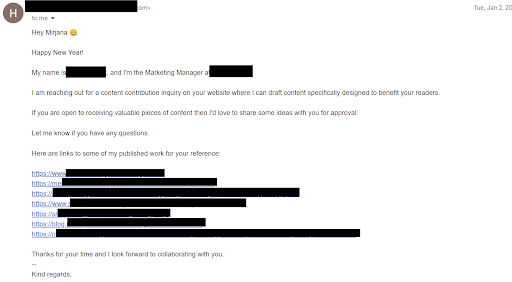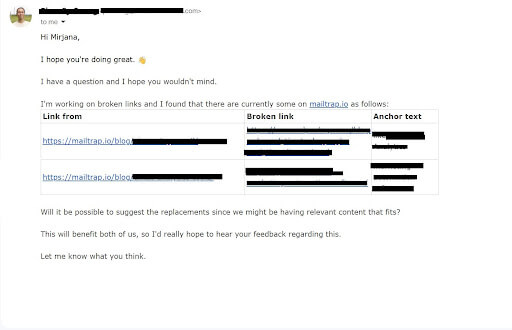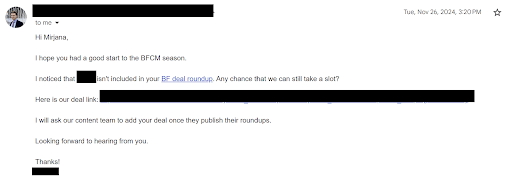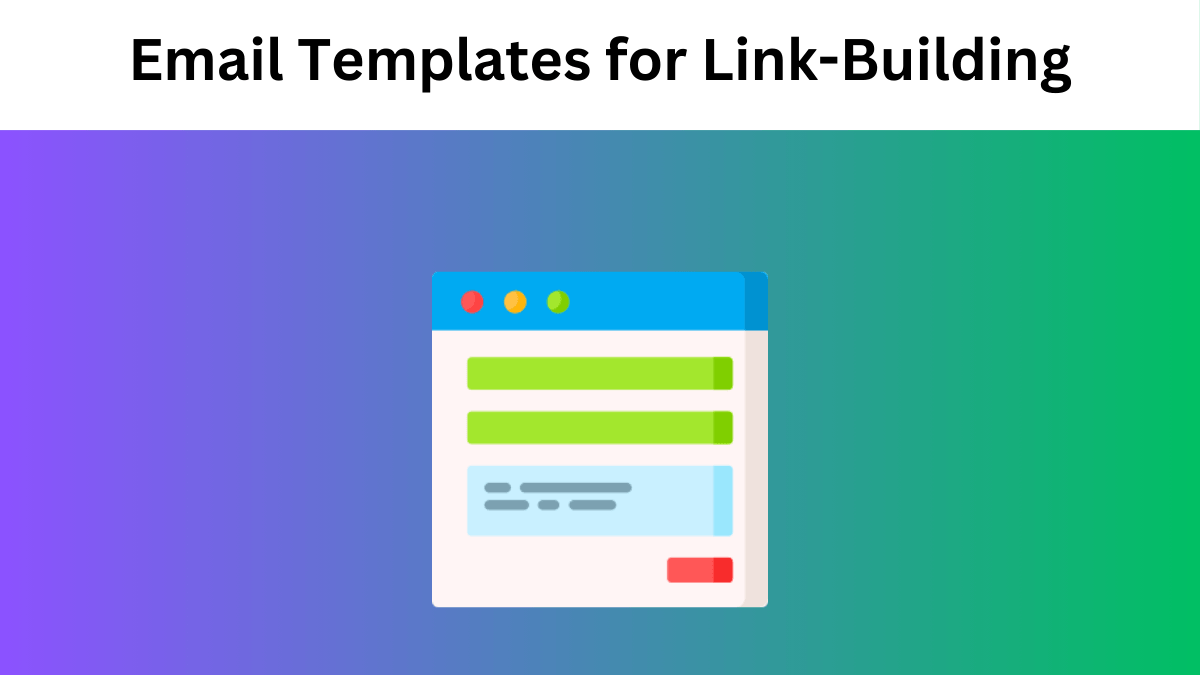Although a simple concept to explain, link-building is hard to get right. With millions of outreach campaigns starting daily, it’s difficult to stand out and persuade your prospects to read your message and take action.
The hard part is – you only get a second of their time before they move on to the next inquiry. That’s where a well-crafted email template for link building can prove to be helpful.
In this blog post, we’ll provide a detailed guide to building a compelling email template, following the best practices, with a few examples and use cases. Let’s get started.
The importance of Email Templates for Link Building
Link-building takes a lot of work. Researching the market and analyzing your competition’s links, sorting out potential prospects, contacting them, and following up is a time-consuming effort.
Now, imagine if you had to write each email sequence from scratch. That alone would keep you busy to no end. That’s where email templates shine. They allow you to send premade, tried-and-tested messages that let you use your time for other tasks.
Not only that, but with email templates you’re prepared for every campaign scenario, making you prepared in advance. However, having pre-made templates doesn’t mean there’s no work involved. You still have to do your research, personalize your messages, and show your prospects your expertise.
Best practices for effective link-building emails
Mindlessly sending out emails can only hurt your campaigns. In other words, you’re likely to end up in the spam folder.
To prevent this from happening, you need to do some thorough research before contacting the publications and editors. As with everything, there’s a right and wrong way of doing this.
Let’s check out some of the best practices that will keep your contacts engaged.
1) Measure twice, cut once
Website editors and content managers usually get dozens (if not even more) of link-building inquiries daily. The safest way to disqualify yourself from the race is to send out an email full of typos and grammar errors.
Your message might be clear and concise, but failing to edit your message comes off as inattentive and sluggish.
Look at this from your perspective. Would you continue the conversation with someone who gives off a vibe of someone who could not be bothered while countless other prospective partners are waiting in queue?
2) Know your audience
On a similar note, doing your due diligence on relevant individuals in the company will get you a couple of steps ahead.
First of all, you should avoid sending emails to generic company addresses (like [email protected]). There are two reasons why this usually doesn’t work:
- You haven’t taken the time to dig deeper, which can make you look uninterested in a genuine interaction;
- These emails are usually reserved for more general inquiries.
Second, there are most likely only a handful of people within your desired company at any given time who are decision-makers. And it’s their stamp of approval you want to be able to get in. So, taking a couple of extra hours to track them (either on LinkedIn or Google) could prove well worth it, if your message doesn’t get ignored. To speed up this process, you can use email finding tools like Hunter that will help you identify and find the email addresses of decision-makers in seconds.
3) Personalize your approach
Just ask any SEO or content manager how many “Dear Sir or Madam” emails they get daily. Individuals sending out these have become subjects of ridicule over the years, but this terrible practice doesn’t seem to be going away anytime soon.
A lot of link builders approach this game from a completely wrong perspective. They use the head-on approach where they jump in and immediately ask for a backlink without ever establishing a meaningful connection.
You need to make sure you’ve:
- Got their name right;
- Researched their expertise and past activities (like blog posts, publications, and media appearances);
- Taken your time to come up with a unique message and subject line.
Such an approach will show that you’re willing to add value to this relationship and are willing to go the extra mile to make it happen.
4) Return the favor
The chances of landing a link in the first place are not high, and without offering something in return, they can come down to zero.
Your prospect needs to be aware of your value offer, and you need to present it clearly and concisely. They need to recognize the benefits by just skimming through the email. These benefits could be:
- A guest post you’d write for them;
- A backlink to their site in return;
- Sharing their content on your social channels.
These are just some of the examples; you can get creative here and offer anything you feel might add value to your prospect. Just make sure your CTA is clearly defined and enticing.
5) Test and adapt
Not every email campaign will land on the first go. More likely than not, you’ll have to adapt your outreach templates and track their success. In return, it will help you craft a message that converts best.
Sometimes you’ll have to tweak your CTA and make it more appealing. Maybe your subject line is not enticing enough or it doesn’t convey a clear message of what you’re after. Or your value proposition is not pushing the right buttons with the prospect.
All in all, your safest bet is to diligently track your metrics like open rates, unsubscribe rates, or number of replies. Using an email marketing provider that allows you to set your desired metrics and track your KPIs will help you determine whether you just need to tweak your templates a bit or need a complete overhaul.
Different types of link-building email templates
There are dozens of different link-building campaigns you could undertake and each of them requires a distinct approach. Each email template should be crafted to fit a certain narrative, and failing to adjust will diminish your returns.
For example, a guest post outreach message should be different from a partnership proposition. We’ve listed the six most common email templates you’ll deal with when running a link-building campaign:
1) Guest post outreach

Guest post requests are among the most common and straightforward outreach techniques. Asking for a guest post boils down to convincing the person in charge to publish your piece of content (if it meets their standards) in exchange for a backlink.
This template should be clear and to the point, where you introduce yourself briefly, showcase your expertise, offer some topics you could cover, and clearly define the reasons why you’d like to write for them. They get a fresh and original post in return.
2) Broken link-building
Often, when doing your prospect research, you’ll come across pages with dead or broken links. You aim to inform the website manager of a broken link on one of their pages. In return, you offer an alternative resource that provides equal or greater value to the reader. They get a fresh update of their page, and you get a backlink without having to write a new piece of content.
Your broken link email template should quickly provide insight into the issue you found on their website while discreetly asking for a link. It should come off as a genuine note aimed at helping them, while a backlink would only be a plus for both of you. The key here is not to push too strongly on this issue, but rather let it develop into a relationship.

3) Link insertion

With link insertion templates, you’re asking a content manager to add your link to an existing article or page on their website. You could also ask them to add you to their roundup posts or resource lists.
The difference between this technique and guest posting is that you don’t have to write a brand-new post, which can work in your favor. Bear in mind that this technique is best suited for established websites. You’ll be hard-pressed to convince webmasters to add a backlink to your site without showcasing value you could add to theirs.
4) Skyscraper technique
The term Skyscraper Technique has been going around for a long time now, and Brian Dean of Backlinko has popularized it. It’s a simple technique; however, it requires a lot of effort on your side.
You pinpoint a piece of content you’d like to outrank and write an improved and more detailed version of it. After that, your goal is to use SEO tools that will let you determine which websites are linking to that competing article. The goal of a Skyscraper email template is to convince those websites to replace those backlinks with your own.
This template should undoubtedly showcase why they should even bother and replace those links. Therefore, the value of your offer and your article should be visible at first glance.
5) Collaboration and partnership outreach
Partnership and collaboration templates aim to establish long-lasting relationships that benefit both parties. It’s not a one-off collaboration, but something you’ll both actively participate in.
The goal of these campaigns is not just a link swap, but rather introducing yourself to your partner’s audience and solidifying your brand. Just make sure your core values and visions match.
7) Following up

Follow-ups are crucial for the success of an outreach campaign. Your initial email will often get lost in a sea of messages in your prospect’s inbox. So, using a quick reminder to nudge them in the right direction is necessary. To ensure you don’t forget to send follow-ups, you can add them as recurring tasks in a smart checklist tool, keeping your efforts consistent and organized. You’ll often learn that after a follow-up they’re willing to collaborate even though they failed to answer your initial message.
A follow-up template should be quick and brief, reminding them of your previous attempt to get a hold of them. Revisit your main points from the first message but in a shorter form. Don’t overdo this! One or two follow-ups are enough. After that, it’s time to move on.
Conclusion
Getting quality results from cold outreach link-building campaigns is harder than ever. You need to keep countless aspects in mind if you want successful campaigns.
Email templates can provide a solid support system that allows you to adapt quickly, send personalized emails in bulk, and improve your chances of higher open rates. In the end, no matter which type of campaign you’re running, your templates should be relevant, concise, valuable, and personalized. Following these rules will get you miles ahead of your competition.


Comments are closed